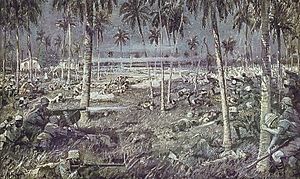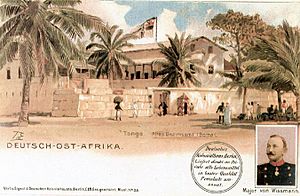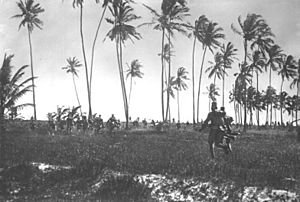Battle of Tanga facts for kids
Quick facts for kids Battle of Tanga |
|||||||
|---|---|---|---|---|---|---|---|
| Part of the East African Campaign of World War I | |||||||
 "Battle of Tanga, 3rd–5th November, 1914" by Martin Frost (1875–1927) |
|||||||
|
|||||||
| Belligerents | |||||||
|
|||||||
| Commanders and leaders | |||||||
| Strength | |||||||
| 250 (Initially) 750 (Reinforcements) Total: 1,000 |
4,000 (Initially) 5,000 (Reinforcements) 1 Astraea-class cruiser Total: 9,000 |
||||||
| Casualties and losses | |||||||
| 16 Germans killed 55 Askaris killed 76 Germans & Askaris wounded |
360 killed 487 wounded 148 missing |
||||||
The Battle of Tanga, also known as the Battle of the Bees, was an important event during World War I. It happened in November 1914 in German East Africa, which is now part of Tanzania. This battle was the first big fight in the East African part of the war.
The British Indian Expeditionary Force "B", led by Major General Arthur Aitken, tried to capture the city of Tanga. However, they were defeated by a much smaller German force. This German force was made up of Askaris (African soldiers serving in colonial armies) and local volunteers. They were led by Lieutenant Colonel Paul von Lettow-Vorbeck.
The German victory at Tanga was a big success for their forces, known as the Schutztruppe. The British had to retreat and left behind a lot of modern equipment. This equipment, including machine guns, medical supplies, and food, helped the Germans fight for the rest of the war.
Why the Battle Happened
Tanga was a very busy port city. It was only about 80 kilometers (50 miles) from British East Africa (modern-day Kenya). Tanga was also the end point of an important railway line. This railway went from Tanga all the way to Neu Moshi, near Mount Kilimanjaro.
At first, there was an agreement to keep Tanga and the capital city, Dar es Salaam, neutral. This meant they would not be attacked. But the British decided to change this agreement. They planned to attack Tanga from the sea.
On November 2, 1914, a British warship called HMS Fox arrived. Its commander, Captain Francis Wade Caulfeild, went ashore. He gave Tanga one hour to surrender and take down the German flag. He also asked if the harbor had hidden mines. The Germans said yes, even though it didn't.
After three hours, the German flag was still flying. The Fox then left to bring in a large group of fourteen British troop ships. This delay gave the Germans and the people of Tanga time to get ready for the attack.
The German commander, Lieutenant Colonel Paul Emil von Lettow-Vorbeck, quickly came to Tanga. He strengthened the city's defenses. At first, there was only one company of Askaris. But more troops arrived by train from Neu Moshi. Eventually, the German force grew to about 1,000 soldiers in six companies. His second-in-command was Captain Tom von Prince.
The Battle Begins
On November 2 and 3, Captain Caulfeild ordered his ships to check the harbor for mines. While this was happening, the British commander, Aitken, started landing his troops. They landed in two places: at the harbor and on a beach about three miles east of the city. There was no resistance during the landing. By the evening of November 3, most of the British invasion force was ashore.
At noon on November 4, Aitken ordered his troops to march towards the city. But the German defenders were well hidden. They quickly stopped the British advance. The fighting then became very difficult. Some fighting happened in the coconut and palm oil plantations. Other fighting was intense street-fighting near the harbor.
Some British units, like the Gurkhas and the Loyal North Lancashire Regiment, made good progress. They entered the town and captured some buildings. But then their advance stopped. Other Indian battalions were not as well trained or equipped. They scattered and ran away from the battle.
The Battle of the Bees
During the fighting, something unusual happened. Swarms of angry bees attacked the 98th Indian Infantry unit. This caused them to break apart and run. The bees also attacked the German soldiers. This is why the battle is sometimes called the "Battle of the Bees." Later, British stories claimed the Germans had set up trip wires to make the bees angry.
The German forces received more soldiers by train. These new troops helped strengthen the German lines. By late afternoon on November 4, Lettow-Vorbeck ordered his last reserves to attack. They launched bayonet charges along the entire front. They used bugle calls and loud tribal war cries. Many British soldiers ran away in a complete retreat.
However, there was some confusion among the German officers. Due to mistakes by buglers and misunderstandings, the Askari soldiers pulled back to a camp outside Tanga. As soon as Lettow-Vorbeck found out, he ordered them to return. But this took time. For much of the night, Tanga was open for the British to take. This was a strange twist in the battle.
After the Battle
General Aitken was very angry and frustrated. He ordered a full withdrawal. As the British troops retreated and got back on their ships, they left almost all their equipment behind.
This was a huge gain for the Germans. Lettow-Vorbeck was able to arm three Askari companies with modern rifles. He also got 600,000 rounds of ammunition, sixteen more machine guns, and valuable field telephones. There was enough clothing to last his soldiers for a year.
On the morning of November 5, a British officer named Captain Richard Meinertzhagen entered Tanga under a white flag. He brought medical supplies. He also carried a letter from General Aitken, apologizing for shelling the hospital. The streets of Tanga were full of dead and wounded soldiers. German doctors and their African helpers worked tirelessly to care for everyone.
The successful defense of Tanga was a major achievement for Paul von Lettow-Vorbeck. It was the first of many successes he would have in East Africa. For the British, however, the battle was a disaster. It was called "one of the most notable failures in British military history."
The British lost 360 soldiers killed and 487 wounded. The Germans lost 16 Germans and 55 Askaris killed, and 76 total wounded. Paul von Lettow-Vorbeck later estimated that more than 2,000 British soldiers might have been killed. The Germans later released the British officers who were wounded or captured. They were set free after promising not to fight again in the war.
See also





